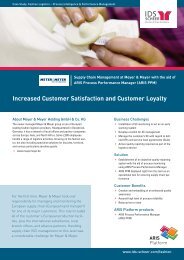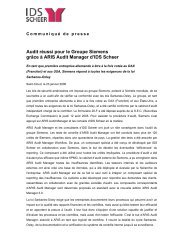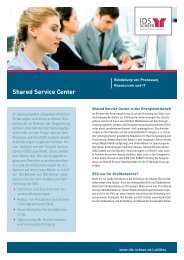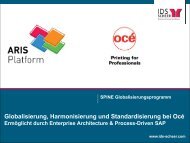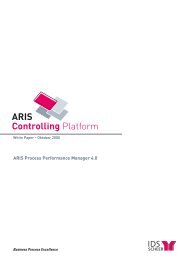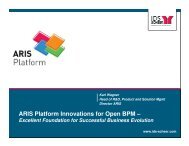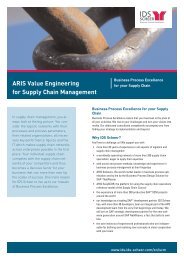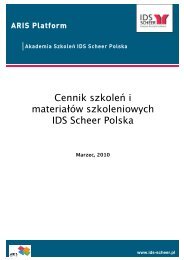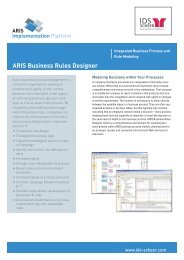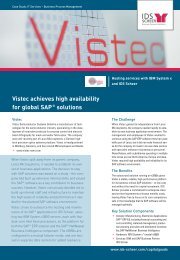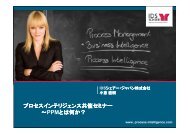ARIS Expert Paper - From Business Process to ... - Software AG
ARIS Expert Paper - From Business Process to ... - Software AG
ARIS Expert Paper - From Business Process to ... - Software AG
You also want an ePaper? Increase the reach of your titles
YUMPU automatically turns print PDFs into web optimized ePapers that Google loves.
<strong>ARIS</strong> <strong>Expert</strong> <strong>Paper</strong><br />
<strong>From</strong> <strong>Business</strong> <strong>Process</strong> <strong>to</strong><br />
Enterprise Architecture<br />
<strong>ARIS</strong><br />
Platform<br />
<strong>Expert</strong><br />
<strong>Paper</strong><br />
<strong>ARIS</strong> Solution for<br />
Enterprise Architecture Management<br />
www.ids-scheer.com
<strong>ARIS</strong> <strong>Expert</strong> <strong>Paper</strong><br />
<strong>From</strong> <strong>Business</strong> <strong>Process</strong> <strong>to</strong> Enterprise Architecture<br />
<strong>ARIS</strong> Solution for Enterprise Architecture Management<br />
Corporate growth typically goes hand in hand with an increasingly complex<br />
IT environment. Mergers add <strong>to</strong> the problem by creating redundancy, while<br />
shrinking system lifecycles necessitate more flexible IT architecture management.<br />
It becomes increasingly difficult <strong>to</strong> identify business-critical systems,<br />
and cost-cutting targets prove elusive. Aligning IT structures with an<br />
organization’s objectives and business processes is the only way <strong>to</strong> achieve<br />
sustained improvements and a significant reduction in the cost of developing,<br />
maintaining, and upgrading IT systems. This paper shows how <strong>ARIS</strong><br />
Solution for Enterprise Architecture Management allows IT infrastructures<br />
<strong>to</strong> be aligned with corporate processes and enables long-term IT architecture<br />
management.<br />
Find out how:<br />
� <strong>ARIS</strong> Solution for Enterprise Architecture Management can be<br />
used <strong>to</strong> align IT systems with the needs of corporate processes<br />
and<br />
� long-term IT architecture management can be implemented.<br />
The business processes in <strong>to</strong>day’s organizations are based on highly sophisticated<br />
enterprise-wide IT systems. Enterprise architectures (EA for short) are the<br />
key <strong>to</strong>ol for documenting, analyzing, and managing the complex information this<br />
involves. They form part of an architecture framework that describes the content<br />
required for a complete architecture.<br />
Fig. 1: Support for multiple enterprise architecture frameworks<br />
2<br />
About the Authors:<br />
Dirk Maurer<br />
is the IDS Scheer <strong>AG</strong> development<br />
manager responsible for the <strong>ARIS</strong><br />
Design Platform products<br />
Patrick Büch<br />
is an IDS Scheer project manager<br />
responsible for enter prise architecture<br />
and designing/developing<br />
<strong>ARIS</strong> Solution for Enterprise<br />
Architecture Management.<br />
Contact:<br />
arisproductmarketing@ids-scheer.com
<strong>ARIS</strong> Solution for Enterprise Architecture Management enables companies <strong>to</strong> create, update, and optimize enterprise<br />
architectures based on architecture standards, such as DoDAF, Zachman, TOGAF, Archimate, and IT City Planning. The<br />
<strong>ARIS</strong> house acts as the basis for the different EA frameworks (fig. 1). The fact that the framework-specific methods are<br />
linked <strong>to</strong> the various <strong>ARIS</strong> method views, and <strong>to</strong> the central <strong>ARIS</strong> reposi<strong>to</strong>ry, gives companies a holistic view of their<br />
entire organization.<br />
Fig. 2: <strong>From</strong> business processes <strong>to</strong> IT systems<br />
<strong>ARIS</strong> <strong>Expert</strong> <strong>Paper</strong><br />
Pivotal <strong>to</strong> the <strong>ARIS</strong> method is an object-oriented approach for reusing architecture artifacts across different views. This<br />
makes it possible <strong>to</strong> recognize how corporate strategy, business processes, and IT architectures interact and <strong>to</strong> build the<br />
necessary bridges. An enterprise architecture compromises four different architecture descriptions, as shown in figure<br />
2.<br />
The business architecture defines business strategies and describes organizational structures and business processes.<br />
The application architecture describes the services and application systems that support the business processes.<br />
The information architecture describes the business objects and data that are exchanged between process participants<br />
and applications.<br />
The lowest level is the infrastructure architecture, which is used <strong>to</strong> describe the physical landscape – the hardware<br />
and networks that support the application systems.<br />
3
<strong>ARIS</strong> <strong>Expert</strong> <strong>Paper</strong><br />
This type of description highlights the impact of business process changes on the associated IT systems. System redundancy<br />
can be detected and new IT<br />
requirements identified. Similarly, the<br />
business processes affected by system<br />
shutdowns and infrastructure<br />
changes can be easily identified. For<br />
this reason, the methods and integrational<br />
<strong>to</strong>ols used for IT architecture<br />
management must create a<br />
structure that is fully synchronized<br />
with process management. The <strong>ARIS</strong><br />
Value Engineering for Enterprise<br />
Architecture (AVE for Enterprise<br />
Architecture) method provides models<br />
and procedures based on <strong>ARIS</strong><br />
Platform <strong>to</strong>ols that enable corporate<br />
IT architectures <strong>to</strong> be aligned with<br />
strategic business needs. The objective<br />
is an awareness that system<br />
architectures are a means <strong>to</strong> an end,<br />
and not an end in themselves –<br />
because businesses face an ongoing<br />
need <strong>to</strong> adapt <strong>to</strong> changing circum-<br />
Fig. 3: Value added chain diagram<br />
stances and priorities.<br />
1 <strong>Business</strong> architecture<br />
The key function of information technology<br />
is <strong>to</strong> support and optimize<br />
corporate processes. Accordingly, IT<br />
strategy should reflect corporate<br />
strategy. IT archi tectures need <strong>to</strong> be<br />
documented, analyzed, and optimized<br />
from a business process perspective.<br />
Based on this in sight, the<br />
<strong>ARIS</strong> method begins by recording the<br />
corporate processes in <strong>ARIS</strong><br />
<strong>Business</strong> Architect, supported by a<br />
special process model. During the<br />
design phase, users can define core<br />
elements of an architecture, such as<br />
organizational units, application systems,<br />
data, and IT system requirements.<br />
Figure 4 shows a sample business<br />
process, documenting and<br />
highlighting the relationship between<br />
activities, data, participants, and<br />
systems.<br />
4<br />
Fig. 4: Relationship between activities, data, participants, and systems
Fig. 5: Relationship between corporate locations, business processes, and the<br />
underlying IT systems<br />
Fig. 6: IS functions form the link here between business processes and IT systems<br />
<strong>ARIS</strong> <strong>Expert</strong> <strong>Paper</strong><br />
Figure 5 is an organizational “map”<br />
that shows the relationship between<br />
corporate locations, business<br />
processes, and the underlying IT systems.<br />
This is what specialist planners<br />
work with. Docu menting and<br />
analyzing existing structures in this<br />
way is the first step <strong>to</strong> creating an<br />
optimized blueprint for future development.<br />
Corresponding data attributes<br />
are used <strong>to</strong> map the lifecycle of<br />
an IT system with regard <strong>to</strong> process<br />
support at a specific location. The<br />
states of the IT system indicated by<br />
the data are reflected in the colored<br />
marking. Yellow and green stand for<br />
“To be phased in” and “Phased in,”<br />
while orange and red are used <strong>to</strong> signal<br />
“To be phased out” and “Phased<br />
out.”.<br />
5
<strong>ARIS</strong> <strong>Expert</strong> <strong>Paper</strong><br />
Dialogs and specific functionalities assist the planner when capturing and updating planning data. A special reporting<br />
mechanism allows data <strong>to</strong> be aggregated for further analysis and <strong>to</strong> generate overviews (“maps”), making it possible <strong>to</strong><br />
come up with concrete measures for enhancing corporate IT structures as a result of this activity.<br />
Special generation mechanisms<br />
allow views of the future infrastructure<br />
<strong>to</strong> be created, so comparisons<br />
with <strong>to</strong>-be / reference installations<br />
are possible (current state architecture<br />
vs. future state architecture).<br />
Importantly, periodic progress<br />
assess ments can thus be made and<br />
plans compared with the current status.<br />
Examining the application structures<br />
of major IT organizations in the age<br />
of outsourcing, outtasking, and<br />
extensive M&A activity frequently<br />
reveals heterogeneous system landscapes<br />
with some data possibly held<br />
in duplicate. If no attempt at harmonization<br />
is made, failure <strong>to</strong> achieve<br />
expected synergy benefits will be<br />
accompanied by long-term additional<br />
cost for avoidable upgrading of legacy<br />
systems.<br />
6<br />
Fig. 7: IT system embedded in a business process<br />
Fig. 8: IS functions as the link between processes and IT systems<br />
For the purposes of detailed analysis,<br />
it is therefore crucial <strong>to</strong> know how<br />
processes are executed in the individual<br />
parts of the company, how<br />
they interact, and what impact<br />
changes might have.<br />
IS functions (information system<br />
functions, fig. 8) form the link here<br />
between business processes and IT<br />
systems (fig. 6). The purpose of these<br />
objects is <strong>to</strong> enable a system <strong>to</strong> be<br />
defined in terms of its functionality.<br />
This allows them <strong>to</strong> be reused in<br />
business processes <strong>to</strong> document the<br />
IT system functionality required by a<br />
specific business function (fig. 7). An<br />
impact analysis then provides an<br />
easy way of establishing the extent<br />
<strong>to</strong> which an IT system is embedded in<br />
business processes and whether<br />
some IT systems duplicate the same<br />
functionality.
2 Application architecture<br />
The application architecture is described using<br />
multiple views, which are presented in the following<br />
sections.<br />
2.1 IT system environment<br />
The model below (fig. 9) groups the applications<br />
in<strong>to</strong> several thematic blocks, allowing exact mapping<br />
of applications <strong>to</strong> several subsystems<br />
across a number of levels.<br />
2.2 Architecture <strong>to</strong>olkit<br />
Fig. 10: Architecture <strong>to</strong>olkit<br />
The aim of standardization is <strong>to</strong> cut maintenance<br />
costs, but reducing the diversity of deployed<br />
technologies can also deliver savings on staff<br />
training and the procurement of hardware and<br />
software.<br />
Fig. 9: IT system environment<br />
An architecture <strong>to</strong>olkit is used <strong>to</strong> manage all the<br />
technologies deployed in an organization. It<br />
allows an IT architect <strong>to</strong> define standards as a<br />
means of harmonizing future development of the<br />
IT environment. Figure 10 shows an example of<br />
an architecture <strong>to</strong>olkit. Additional models can be<br />
used <strong>to</strong> display information in greater detail, like<br />
the model for database system management in<br />
figure 11. Each of these database objects contains<br />
information that includes the manufacturer,<br />
version, and links <strong>to</strong> the relevant manuals. A<br />
database object also contains information about<br />
the standardization status:<br />
“Standard,” “Non-standard,” etc.<br />
Fig. 11: Database system with standardization status<br />
<strong>ARIS</strong> <strong>Expert</strong> <strong>Paper</strong><br />
7
<strong>ARIS</strong> <strong>Expert</strong> <strong>Paper</strong><br />
2.3 Reference architectures<br />
The objective of reference architectures<br />
is <strong>to</strong> reuse concepts and software<br />
components. They lay down<br />
requirements targeted at creating a<br />
more uniform IT system landscape.<br />
<strong>Software</strong> suppliers need <strong>to</strong> meet<br />
these requirements with regard <strong>to</strong><br />
design principles, infrastructures,<br />
and technologies. Reference architectures<br />
thus help <strong>to</strong> harmonize IT<br />
infrastructures, which in turn cuts<br />
operating costs.<br />
2.4 System description<br />
Access diagrams are used <strong>to</strong><br />
describe systems at the type level<br />
(fig. 12). The type level (often also<br />
called the “logical view”) contains<br />
information about the underlying<br />
operating system, programming language,<br />
database, hardware type,<br />
organization responsible, and person<br />
responsible for the application.<br />
Keeping this information up <strong>to</strong> date is<br />
the task of the application owner.<br />
Fig. 13: Navigation and analysis functions<br />
8<br />
Fig. 12: Access diagram<br />
Navigation and analysis functions<br />
(fig. 13) are used for such purposes<br />
as identifying the systems that feature<br />
specific technologies. This<br />
makes it possible <strong>to</strong> analyze the<br />
impact of a change of technology,<br />
provider, or version, and <strong>to</strong> inform /<br />
involve the relevant persons.
Fig. 14: Program flow chart<br />
2.5 Information architecture<br />
The following diagram (ERM, fig. 15)<br />
shows a more detailed description of<br />
the data. This data can be reused in<br />
process descriptions covering<br />
input/output data relating <strong>to</strong> specific<br />
activities, the data flow, and data<br />
exchange between process participants.<br />
The data objects also serve as<br />
the basis for describing data<br />
exchange between applications, and<br />
can be s<strong>to</strong>red with the interfaces.<br />
Fig. 15: Data model<br />
<strong>ARIS</strong> <strong>Expert</strong> <strong>Paper</strong><br />
The interfaces between a system and<br />
other systems can also be identified<br />
e. g. information about the data ex -<br />
changed, pro<strong>to</strong>cols used, etc., can<br />
also be s<strong>to</strong>red here. Here again, this<br />
view enables the impact of system and<br />
interface changes <strong>to</strong> be analyzed.<br />
9
<strong>ARIS</strong> <strong>Expert</strong> <strong>Paper</strong><br />
2.6 Infrastructure architecture<br />
In addition <strong>to</strong> description at the type<br />
level, systems are also described at<br />
the physical level (instances).<br />
Instances can have information<br />
associated with them, such as hardware<br />
used, network segments, system<br />
support responsibility, ports, and<br />
IP addresses.<br />
The following diagram (fig. 16) shows<br />
various different instances of application<br />
systems.<br />
Fig. 17: Network diagram<br />
10<br />
Fig. 16: Application system instances<br />
Network diagrams (fig. 17) allow the<br />
relationship between networks,<br />
routers, switches, and hardware<br />
(servers, printers, etc.) <strong>to</strong> be shown.<br />
The icons used here can be modified<br />
<strong>to</strong> suit specific user needs, as can<br />
those in the other diagrams.
3 Reporting<br />
The information held in the central reposi<strong>to</strong>ry of <strong>ARIS</strong> Solution for Enterprise Architecture Management can be evaluated<br />
in a number of different ways and made available <strong>to</strong> the relevant target groups. In addition <strong>to</strong> standard navigation functionality<br />
within the process and architecture models, au<strong>to</strong>mated reports, macros, and search mechanisms are also available,<br />
which are specifically designed <strong>to</strong> meet the needs of enterprise architecture management. A number of standard<br />
reports are described below.<br />
3.1 <strong>ARIS</strong> “System Evaluation” report<br />
Based on the application system types<br />
within the selected application system<br />
type diagrams, this report creates a system<br />
portfolio with details of data center<br />
costs and criticality.<br />
3.2 <strong>ARIS</strong> “System List” report<br />
The “System List” report supports creation of various lists depending on the selection set.<br />
Examples include:<br />
� System lists by associated IT standard<br />
� System lists by associated business process<br />
� Lists of IT standards by associated business process<br />
Fig. 18: “System Evaluation” report<br />
<strong>ARIS</strong> <strong>Expert</strong> <strong>Paper</strong><br />
11
<strong>ARIS</strong> <strong>Expert</strong> <strong>Paper</strong><br />
3.3 <strong>ARIS</strong> “System Fact Sheet” report<br />
Based on the architecture data assigned by the individual project team, an overview can be generated for any system<br />
(including au<strong>to</strong>matic generation at defined times). The system fact sheet describes a system with regard <strong>to</strong> contact persons<br />
(person, organizational unit), service level agreements, business functionality, process, and operation.<br />
Fig. 19: “System Fact Sheet” report<br />
12
4 Web-based publication and processing of content<br />
Fig. 20: <strong>ARIS</strong> IT Inven<strong>to</strong>ry<br />
<strong>ARIS</strong> <strong>Expert</strong> <strong>Paper</strong><br />
The cooperation of many user groups is central <strong>to</strong> any enterprise architecture project. Centralized publication of content<br />
is thus vital <strong>to</strong> ensure a shared understanding and on going processing of standardization and development tasks.<br />
<strong>ARIS</strong> Platform provides powerful, dynamic publication components that meet this need, allowing access <strong>to</strong> data via an<br />
intranet portal in a company-specific and role-based manner.<br />
If individual user groups (e.g., application system owners) are <strong>to</strong> be allowed <strong>to</strong> maintain system-specific information, the<br />
<strong>ARIS</strong> IT Inven<strong>to</strong>ry add-on can be used <strong>to</strong> provide a user interface for decentralized data input.<br />
13
<strong>ARIS</strong> <strong>Expert</strong> <strong>Paper</strong><br />
5 Integration with IT service management environments<br />
Many organizations deploy IT<br />
service management systems for<br />
operational management of their<br />
IT infrastructure, which s<strong>to</strong>re<br />
important data relating <strong>to</strong> the<br />
managed infrastructure in a configuration<br />
management database<br />
(CMDB). <strong>ARIS</strong> Solution for Enter -<br />
prise Architecture Manage ment is<br />
able <strong>to</strong> import this instance and<br />
infrastructure information in<strong>to</strong><br />
<strong>ARIS</strong> IT Architect e. g. in order <strong>to</strong><br />
conduct a business impact analysis<br />
in the context of scenario planning.<br />
6 Special roles within an enterprise architecture team<br />
In the context of enterprise architecture management, large IT organizations in particular have adopted specific user<br />
roles, which despite some variation in name focus on the same or similar sets of tasks, as described below.<br />
IT System Manager:<br />
� Documenting and disseminating system information via the intranet<br />
� Planning system transitions based on life cycle and strategic planning<br />
� Providing IT project managers with specification guidelines that comply with corporate IT standards and business<br />
needs<br />
IT Architect:<br />
� Establishing applications and technologies based on the existing IT landscape<br />
� Detailing, documenting, and disseminating enterprise-wide IT standards<br />
� Creating a long-term IT architecture framework<br />
� Integrating and involving process management in the strategic planning framework and IT roadmap definition<br />
IT Development Planner:<br />
� Recording the as-is IT landscape within the organization’s core processes<br />
� Deriving a <strong>to</strong>-be IT deployment plan<br />
� Continuous updating of the IT plan<br />
Architecture Manager:<br />
� Strategic deployment of an architecture framework<br />
� Merging of IT standards and IT system direc<strong>to</strong>ry<br />
14<br />
Fig. 21: <strong>ARIS</strong> and CMDB
7 Summary<br />
<strong>ARIS</strong> <strong>Expert</strong> <strong>Paper</strong><br />
By creating a seamless interconnect between IT and process architecture in a single reposi<strong>to</strong>ry, from strategy through<br />
<strong>to</strong> infrastructure level, <strong>ARIS</strong> Solution for Enterprise Architecture Management makes it possible for the first time <strong>to</strong> fully<br />
align IT systems with business needs.<br />
Benefits include being able <strong>to</strong> identify which critical business processes at which locations are affected and will therefore<br />
need <strong>to</strong> be part of the migration project when replacing an IT system. Planners and architecture managers can navigate<br />
the entire enterprise architecture, following object relationships, and take informed decisions based on a holistic<br />
view of the company and a shared methodology.<br />
Users can compare the IT standards and target architectures defined in the reposi<strong>to</strong>ry with the actual situation and create<br />
a roadmap for future development. Importantly, <strong>ARIS</strong> IT Architect facilitates organization-wide enterprise architecture<br />
management by supporting distributed teams. The resulting architecture information can be documented in the<br />
intranet with the help of <strong>ARIS</strong> <strong>Business</strong> Publisher, a dynamic publishing <strong>to</strong>ol, in a way that meets the needs of specific<br />
groups. In addition <strong>to</strong> designing enterprise architectures, companies can use this functionality <strong>to</strong> set up process and IT<br />
portals.<br />
Bringing <strong>to</strong>gether business process design and IT architectures allows coordinated management of these two areas,<br />
enabling the kind of integrative approach that is particularly important for successful enterprise architecture management,<br />
given the interdependency of processes and IT structures.<br />
15
<strong>ARIS</strong> <strong>Expert</strong> <strong>Paper</strong><br />
© Copyright (C) IDS Scheer <strong>AG</strong>, 2001 – 2009. All rights reserved. The contents of this document is subject <strong>to</strong> copyright law. Changes, abridgments, extensions and supplements<br />
require the prior written consent from IDS Scheer <strong>AG</strong>, Saarbrücken, Germany. Reproduction is only permitted provided that this copyright notice is retained<br />
on the reproduced document. Each publication or translation requires the prior written consent from IDS Scheer <strong>AG</strong>, Saarbrücken, Germany. “<strong>ARIS</strong>”, “IDS”,<br />
“<strong>Process</strong>World”, “PPM”, “MashZone”, <strong>ARIS</strong> with Platform symbol and Y symbol are trademarks or registered trademarks of IDS Scheer <strong>AG</strong> in Germany and in many<br />
countries all over the world. “SAP NetWeaver” is a trademark of SAP <strong>AG</strong>, Walldorf. All other trademarks are the property of their respective owners.<br />
U.S. pat. D561,778, pat. D561,777, pat. D547,322, pat. D547,323, pat. D547,324<br />
ID-Number: EP-EAM-0909-EN<br />
<strong>ARIS</strong><br />
Platform<br />
<strong>Expert</strong><br />
<strong>Paper</strong><br />
IDS Scheer <strong>AG</strong><br />
Headquarters<br />
Altenkesseler Str. 17<br />
66115 Saarbruecken<br />
Phone: +49 681 210-0<br />
Fax: +49 681 210-1000<br />
E-mail:info@ids-scheer.com<br />
www.ids-scheer.com



